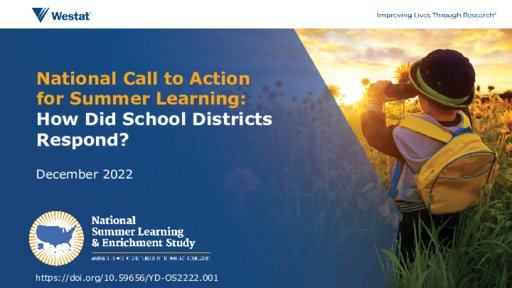Breadcrumb
- Wallace
- Reports
- National Call To Action For Summ...
National Call to Action for Summer Learning
How Did School Districts Respond?

- Author(s)
- Allison Crean Davis, John Hitchcock, Beth-Ann Tek, Emily Diaz, and Molly Hershey-Arista
- Publisher(s)
- Westat
Summary
How we did this
Phase I of the National Summer Learning and Enrichment Study sought to generate findings about 2021 summer learning that reflected the experience of the 13,000+ traditional and public charter schools (collectively known as local education agencies, or LEAs) in the United States. 550 LEAs were randomly sampled within subgroups based on LEA size and poverty.
Research shows that high quality, district-run summer learning programs can increase student achievement. But evidence and best practice guidance apply to a narrow set of conditions—primarily urban settings. To benefit and reach more students, it is important to understand how these results can be replicated in a range of geographic contexts. How can schools reach more students with high quality summer learning, in a variety of different places?
This report from the Westat research organization, the first in a series produced under the National Summer Learning and Enrichment Study (NSLES), helps build this understanding.
A Call to Action
The coronavirus pandemic led to widespread learning disruptions and instructional loss for students. To combat this loss, in March 2021 U.S. political leaders issued a “Call to Action,” calling on school districts and state education agencies to mobilize to provide high quality summer learning opportunities for K-12 students.
This Westat report captures early findings from summer 2021 as state education agencies and school districts mobilized to deliver summer learning programming. It draws on an initial survey of school districts conducted by Westat.

It is important to understand how a national effort for summer learning and enrichment can extend beyond immediate pandemic needs and the American Rescue Plan stimulus funding timeline.
How Did School Districts Respond?
Westat’s survey yielded nationally representative results. It also revealed patterns and common characteristics of summer 2021 programming efforts.
Altogether, Westat found that 94 percent of districts responded to the summer learning call to action. On average, these districts reached one-fifth (18 percent) of their student populations. Elementary school students represented the largest proportion of students served.
Urban school districts served the greatest proportion of students (22 percent). Suburban school districts served the smallest (13 percent). Student data was the most common source of information used to determine which students to prioritize for summer learning opportunities. 67 percent of districts prioritized serving special needs students. Students at risk of failure were the second largest group (66 percent).
“Learning Recovery” was the most common programming approach pursued by implementing districts. This approach focused on providing students with curricula and instruction that was difficult to access during the 2020-21 school year. Three-quarters of school districts implemented learning recovery programming. Most districts, however, adopted more than one programming approach. And more than half (57 percent) supplemented academic programming with social and emotional learning.
The study also found that the majority of districts planned and implemented summer learning on their own. Less than half (41 percent) engaged partners to plan and/or deliver summer programming. Most relied on existing partners. Only six percent engaged new partners.
How did State Education Agencies respond?
Future reports from Westat’s research will examine summer 2021 from state education agencies' perspective. They will also include an analysis of district summer learning plans and draw on data from interviews with state and district officials.
Altogether, these findings will build a better understanding of how a national effort for summer learning and enrichment could extend beyond immediate pandemic needs.
The Wallace Foundation is supporting the study.
Key Takeaways
- 94 percent of U.S. school districts mobilized to deliver summer learning programming in Summer 2021.
- Of those that delivered programming, school districts in cities and rural areas served the greatest proportion of their students (22 percent and 18 percent, respectively). Suburban school districts served the smallest proportion (13 percent).
- “Learning recovery”—supporting students in pursuing learning disrupted by the pandemic —was the most common summer programming approach, used by three-fourth of districts (75 percent).
- More than half of implementing districts (57 percent) supplemented academic programming with social and emotional learning.
- Two-thirds of districts (67 percent) prioritized serving students with special needs.
- Less than half of districts (41%) engaged partners to plan for and/or deliver programming. Of those that did, most relied on existing partners.



